
Tête-à-tête
Harley Hamilton 'Cast Palladiana'
Narrative infused; Harley Hamilton’s designs draw influence from his experience of different spaces and the indelible joy in the fundamental principles of creating them.
With a foundation in architectural design, his transition into product design is one he feels is just another great way to engage with people in the creation of spaces.
Guided by historical influence, Harley likes to strike a balance between history and modernity in his work whenever possible, looking backwards to refine and adapt his application of new technologies.
Immediately drawn to his use of materials and his ability to create such light and refined work from such strong materiality, Tigmi engaged Harley, inviting him to join our exclusive collection of works with his table collection 'Cast Palladiana.'
We hope you enjoy getting to know the designer and artisan behind this exquisite collection, as we take a visit to his Melbourne studio.
With a foundation in architecture design and a multidisciplinary background across design, what are you enjoying about product design?
I'm finding that there is a great challenge in trying to create something that has a universality that can be appreciated and enjoyed by many. It's a change of tempo for me having typically worked with custom projects where a level of mutual understanding can help to ensure a clients pleasure in the final result. Product design requires a different type of physical and cultural durability. The pieces need to be enduring so that they can be passed onto others and be enjoyed beyond their initial design intent. There's a lightness too in the process of designing furniture as it has the liberating effect of its functionality, but I also try to bring a sculptural value to each piece so that it might also be understood as an object and not only as a tool. For me it's just another great way to engage with people in the creation of spaces.
Tigmi has always celebrated the connect between history and modernity, this duality can also be found in your work. Can you talk to us a bit about how you have interpreted history into your designs?
Historical reference is too great a well pool of ideas to overlook and with all of that weight behind us the present is the privileged position from which we can continue and adapt and refine our visual expression. I always want to strike a balance between the two if I can. Fairly often I'll find my work drawing from regional vernacular styles that have taken root in a community - through necessity of materials for example - or as a result of the collective psyche. They are vignettes of their moment. Modernity is much the same. The egalitarian roots of the tradition of Palladiana stone work enabled it to become a vernacular building type as it was an accessible way for many regions to pave the floors of their homes - being that it lends itself to utilising stone offcuts - where stone was readily available. People were then able to be endlessly expressive in the way that they chose to organise these pieces. With the benefit of new material technologies I've been able to change its context somewhat. And I think that in exploring the material dexterity of new technologies we can arrive at something that is necessarily of its time.
We are so excited to be working with you on the launch of your table collection, ‘Cast Palladiana.’ Can you explain your inspiration behind the collection?
It's been on the cooker for a long time and comes from a lot of sources, but in part the catalyst for this body of work was found in some of the old Roman and Byzantine structures. I was intrigued by the small fractured elements that sat isolated in old mortars and cement screeds, or mosaics where only a few sections remained. These elements became so much more significant as the space around it increased. Repaired and patched over time it was the mortar that had become foregrounded. If you imagined that it was intentional - and not the wear of the years - then these compositions became intensely abstract and seemingly modern. That opened up an array of possibilities for me to experiment with, and was a joy to find a way that taps into the lineage of mosaic, palladiana and terrazzo, but that is distinct from it.
 |
|
|
|
|
 |
|
|
|
|
 |
|
What were the considerations you had for the materiality of the collection?
Stone and concrete both have a mineral complexity to them, one with natural imperfections and other human. I needed a base that would support the beautiful figuration of the stone bars, but that also had enough depth to match it. I tried tiling to substrates first, but it seemed sacrilegious not to have the stone and concrete working as one single element.
What details of the designs do you find yourself most delighting in?
The choice to give the stone space to breathe. And the subtle impressions left in the surface of each concrete cast.
Is there a design philosophy you assign yourself to, or do you feel open for new interpretations?
My work is very changeable and I hope that the commissions that come my way continue to be varied. If there's a thread it might be that I always hope to make things appear effortless, as if it all happens despite design. And to distill an idea down to its most basic expression. I think that is when you find something feels right but don't know why, because fuss and distraction have been removed. And balance. Oscar Wilde put it well when he said "everything in moderation including moderation", but maybe that's more of a life philosophy.
"Fairly often I'll find my work drawing from regional vernacular styles that have taken root in a community - through necessity of materials for example - or as a result of the collective psyche. They are vignettes of their moment."
You have noted that there is a narrative ‘fused’ within the structure of the Cast Palladiana collection. How important do you feel it is for design to encapsulate a story?
It's important for the beginning of a project, as a way into a work, but it's just as valuable to be plastic throughout the design process and to know that others will read a work differently to your own intentions. And when there is room for interpretation - or misinterpretation - in a work then that can make a piece far more engaging. It allows others to infuse it with their ideas, their own story. It also depends so much on the project. When a design can reflect an individual or collective attitude then that is a wonderful thing. Architecture has the scope to allow for complex interweaving of narratives of people and place, and sits best when the client(s) are able to see those aspects of their life encapsulated within the realised form. I think it's also important to remember that craft - and design for that matter - is part of an ongoing human experiment, it is inherently narrative based as we build upon the traditions of previous generations.
What do you believe has most inspired your overall approach to design?
I think experiencing good spaces, or I don't know if it is good so much as different spaces. And art. Then I think it's been a slow road trying to find ways to engage with these things - drawing, making, reading, watching, travelling, all of it. And that by the time I was 18 years old I'd lived in 18 houses.That could have had some effect. We moved a lot and I loved it. I've reflected a fair bit since then on what it was that made each strange house so quickly feel like a home. And that question still motivates me.
Tigmi is Berber for ‘my home’, what do feel your creative home of Melbourne adds to your designs?
It's a vibrant culture clash. I like its changeability, particularly in the streetscapes. The city's evolution is legible in the haphazard growth of building typologies vying for space. I think it's a place that encourages pluralism. There's also a strong network of craft, art and designers in Melbourne that have beaten the path before and when you witness them at it that can be just what your spirit needs to keep you creating. But I grew up outside of Melbourne and it's the Victorian bush that feels like home. I'm drawn to its arid and flat sparsely treed woodlands and grasslands where its beauty is subtle and full of complexity. There's a humbleness to it. It doesn't always offer up its greatness, but causes you to look for it. I like that a lot.
_______
Photography by Alicia Taylor.
'Cast Palladiana' table collection is now available exclusively with Tigmi.


















